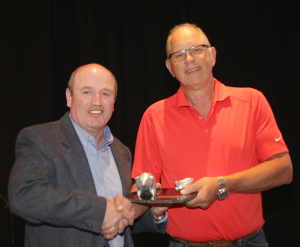Nobody wants to get into a shouting match, but you do have to speak to be heard. The Canadian pork industry is falling behind its nay-sayers in public perception, and producers need to get back in the game soon, says Brent Moen, chairman of the Western Hog Exchange (WHE). Moen, who received the Elanco Pork Industry Ambassador Award at the 2015 Alberta Pork Congress, has been doing his part and more to beat the drum for Alberta’s pork producers.
“Over the last year, the biggest challenge that I’ve been involved in is this whole animal welfare issue and the perception that consumers in Canada have about our industry,” he said. “As producers of food in Canada, we have sat far too long and left our head in the sand and not stood up and told people what we do, why we do it and how we do it to provide the safest food product in the world.”
Media have been paying a lot of attention to “biased information” from groups that are driven by an agenda to challenge the industry, he said. When that’s the only side of the story that the media hears, it’s the only side that will be broadcast or printed. The industry and individual producers need to do a better job of telling the other side.
Animal welfare is at the top of the priority list for Canadian producers, he said. They dedicate their lives to producing quality in an animal-friendly environment.
But occasional shocking events, such as ones caught by W5 hidden cameras last year, are the ones that make the news.
“Do (producers or transporters) make mistakes, and do we have tragedies within our industry? Absolutely. Death is part of life,” Moen noted.
But using those events to judge the industry is like judging the airline industry by the occasional crash, when actual statistics prove that airline travel is incredibly safe. It’s the record of safety and quality that pork producers need to be more vocal about.
“Here’s what we do right 99.9 per cent of the time.”
Of course, the industry is also responsible for maintaining that record, he pointed out.
“As producers and transporters of livestock, we’ve got to make sure that we walk the walk and talk the talk.”
Organizations like WHE are setting examples by hiring an outside inspector to do spot audits, Moen said. They get reports on not just how animals are handled, but also whether the people understand their priorities correctly. It gives WHE a chance to address any issues before they become publicity problems.
But the crucial issue is for the people who know agriculture to tell their stories to the rest of Canada. With the urbanization of Canada’s population, most people are three or four generations away from the family farm, and know very little about it.
“They have no idea how milk is produced, how grain is grown,” Moen said.
They also have no idea what genetic modification means, and jump to all kinds of false conclusions about risks and harms.
Dr. Egan Brockhoff, a veterinarian with Prairie Swine Health Services in Red Deer, agrees that the industry needs to correct the misinformation being fed to the public. Anti-microbial resistance is becoming “a really huge issue in Canada,” he told the Alberta Pork regional meeting in Red Deer in May. Livestock industries are being depicted in ridiculous cartoons as feeding antibiotics to animals by the trough-full, and it’s the only information consumers are getting.
“This is the story the public is being presented with and everyone is reacting,” Brockhoff said. “They’re our animals, but it’s their food, and that’s how they view it.”
Major American grocery and fast-food chains are pressuring the industry to reduce the use of antibiotics and other medications. It will become a reality for the industry, and producers will need to make sure they are using medications exactly correctly. But at the same time the industry needs to get its side of the story out to counter the over-reaction.
“The stories aren’t being told,” Brockhoff lamented.
Producer organizations can lead, but they can’t regain the trust that the public is losing in the agriculture industry. It’s up to individual producers, people who work around the animals every day, to tell the world how they work. They need to talk to friends, families, anyone they know about what they do. He would like to see producers making videos and putting them to Youtube and other social media sites to tell their stories.
“They’re all feeding their families with pork. It’s safe, it’s wholesome,” Brockhoff insisted. “We have probably the safest food in human history, and this country supplies some of that.”
Alberta Pork communications coordinator Geoff Geddes echoed those ideas at the Alberta Pork Congress. Pork producers do excellent work and take a lot of pride in it.
“They’re providing food for the world, and it’s something that they’re really proud of. We need to get that message out more.”
He would love to see producers making videos about animal care, biosecurity or even worker safety, and uploading them to the Internet. Alberta Pork also encourages producers to go to places like the Calgary Stampede and any public event where they can meet the public, educate them and answer questions.
“Sometimes the most vocal people out there are that very small minority who want to knock the industry and do it under the guise of animal welfare,” Geddes said. “What we need to do is be equally vocal in getting the reality out there.” •
— By Carl Haun





